Aviation Operations Management Report: Airline Development Analysis
VerifiedAdded on 2020/12/26
|8
|2202
|317
Report
AI Summary
This report delves into the intricacies of Aviation Operations Management, examining both the commercial and strategic dimensions of the airline industry. It explores the critical aspects influencing airline development globally, emphasizing the importance of business models, fleet size, financial planning, and route networks. The report uses the hypothetical virtual airline, Air Bedfordshire, as a case study to illustrate these concepts. It outlines the airline's business model, focusing on low-cost strategies, hub-and-spoke networks, and marketing initiatives. The report also analyzes the financial projections, fleet composition, and route planning of Air Bedfordshire. The discussion extends to the key considerations that affect airline development, such as dynamic strategic planning, fleet management, and financial sustainability. Overall, the report provides a comprehensive overview of the challenges and opportunities within the aviation industry, emphasizing the need for a well-defined operational and strategic approach to achieve efficiency and profitability.

AVIATION
OPERATIONS
MANAGEMENT
OPERATIONS
MANAGEMENT
Paraphrase This Document
Need a fresh take? Get an instant paraphrase of this document with our AI Paraphraser

Table of Contents
INTRODUCTION...........................................................................................................................1
MAIN BODY...................................................................................................................................1
Evaluating Commercial and Strategic Aspects of Airlines.........................................................1
Requirements and considerations that influence the development of airlines globally..............2
CONCLUSION................................................................................................................................5
REFERENCES................................................................................................................................6
INTRODUCTION...........................................................................................................................1
MAIN BODY...................................................................................................................................1
Evaluating Commercial and Strategic Aspects of Airlines.........................................................1
Requirements and considerations that influence the development of airlines globally..............2
CONCLUSION................................................................................................................................5
REFERENCES................................................................................................................................6
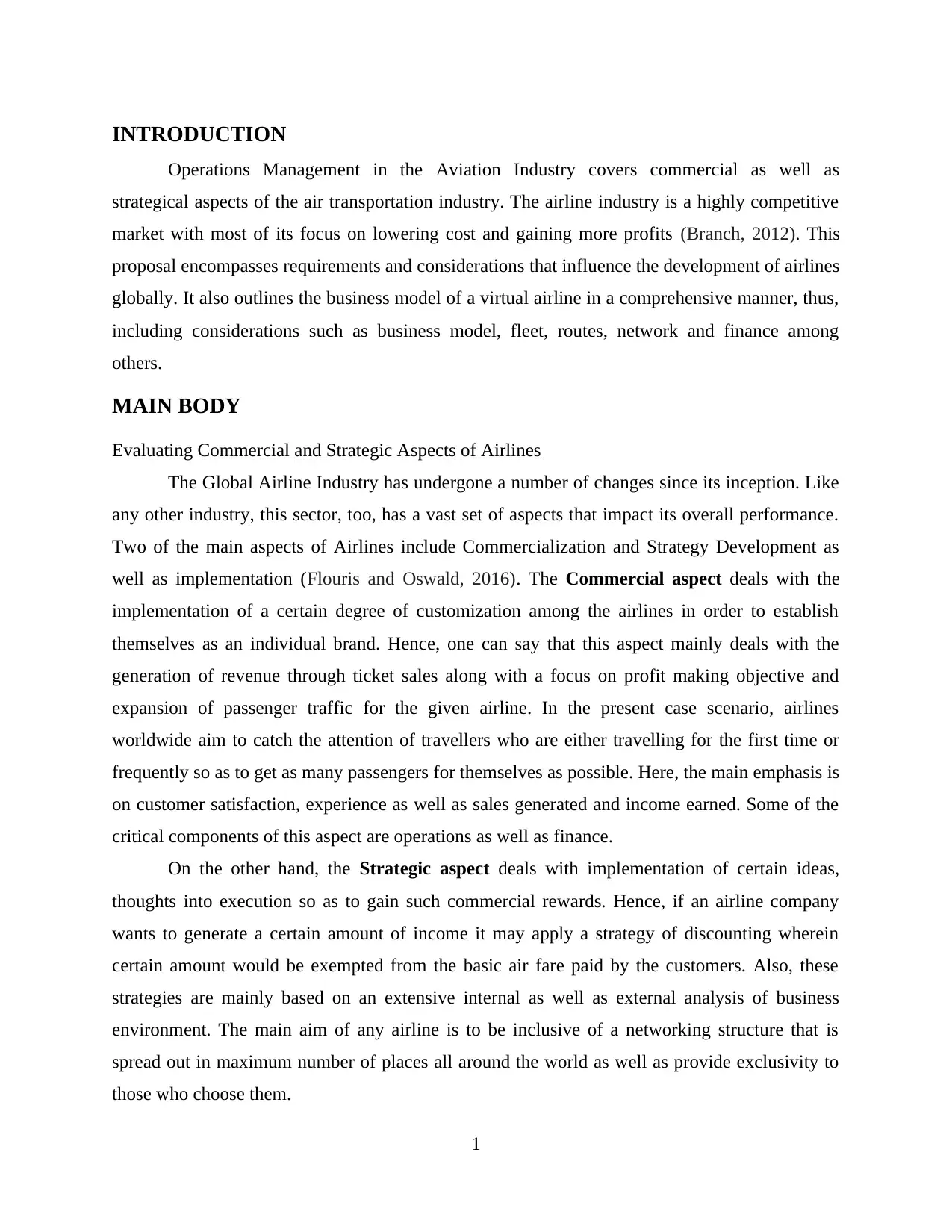
INTRODUCTION
Operations Management in the Aviation Industry covers commercial as well as
strategical aspects of the air transportation industry. The airline industry is a highly competitive
market with most of its focus on lowering cost and gaining more profits (Branch, 2012). This
proposal encompasses requirements and considerations that influence the development of airlines
globally. It also outlines the business model of a virtual airline in a comprehensive manner, thus,
including considerations such as business model, fleet, routes, network and finance among
others.
MAIN BODY
Evaluating Commercial and Strategic Aspects of Airlines
The Global Airline Industry has undergone a number of changes since its inception. Like
any other industry, this sector, too, has a vast set of aspects that impact its overall performance.
Two of the main aspects of Airlines include Commercialization and Strategy Development as
well as implementation (Flouris and Oswald, 2016). The Commercial aspect deals with the
implementation of a certain degree of customization among the airlines in order to establish
themselves as an individual brand. Hence, one can say that this aspect mainly deals with the
generation of revenue through ticket sales along with a focus on profit making objective and
expansion of passenger traffic for the given airline. In the present case scenario, airlines
worldwide aim to catch the attention of travellers who are either travelling for the first time or
frequently so as to get as many passengers for themselves as possible. Here, the main emphasis is
on customer satisfaction, experience as well as sales generated and income earned. Some of the
critical components of this aspect are operations as well as finance.
On the other hand, the Strategic aspect deals with implementation of certain ideas,
thoughts into execution so as to gain such commercial rewards. Hence, if an airline company
wants to generate a certain amount of income it may apply a strategy of discounting wherein
certain amount would be exempted from the basic air fare paid by the customers. Also, these
strategies are mainly based on an extensive internal as well as external analysis of business
environment. The main aim of any airline is to be inclusive of a networking structure that is
spread out in maximum number of places all around the world as well as provide exclusivity to
those who choose them.
1
Operations Management in the Aviation Industry covers commercial as well as
strategical aspects of the air transportation industry. The airline industry is a highly competitive
market with most of its focus on lowering cost and gaining more profits (Branch, 2012). This
proposal encompasses requirements and considerations that influence the development of airlines
globally. It also outlines the business model of a virtual airline in a comprehensive manner, thus,
including considerations such as business model, fleet, routes, network and finance among
others.
MAIN BODY
Evaluating Commercial and Strategic Aspects of Airlines
The Global Airline Industry has undergone a number of changes since its inception. Like
any other industry, this sector, too, has a vast set of aspects that impact its overall performance.
Two of the main aspects of Airlines include Commercialization and Strategy Development as
well as implementation (Flouris and Oswald, 2016). The Commercial aspect deals with the
implementation of a certain degree of customization among the airlines in order to establish
themselves as an individual brand. Hence, one can say that this aspect mainly deals with the
generation of revenue through ticket sales along with a focus on profit making objective and
expansion of passenger traffic for the given airline. In the present case scenario, airlines
worldwide aim to catch the attention of travellers who are either travelling for the first time or
frequently so as to get as many passengers for themselves as possible. Here, the main emphasis is
on customer satisfaction, experience as well as sales generated and income earned. Some of the
critical components of this aspect are operations as well as finance.
On the other hand, the Strategic aspect deals with implementation of certain ideas,
thoughts into execution so as to gain such commercial rewards. Hence, if an airline company
wants to generate a certain amount of income it may apply a strategy of discounting wherein
certain amount would be exempted from the basic air fare paid by the customers. Also, these
strategies are mainly based on an extensive internal as well as external analysis of business
environment. The main aim of any airline is to be inclusive of a networking structure that is
spread out in maximum number of places all around the world as well as provide exclusivity to
those who choose them.
1
⊘ This is a preview!⊘
Do you want full access?
Subscribe today to unlock all pages.

Trusted by 1+ million students worldwide
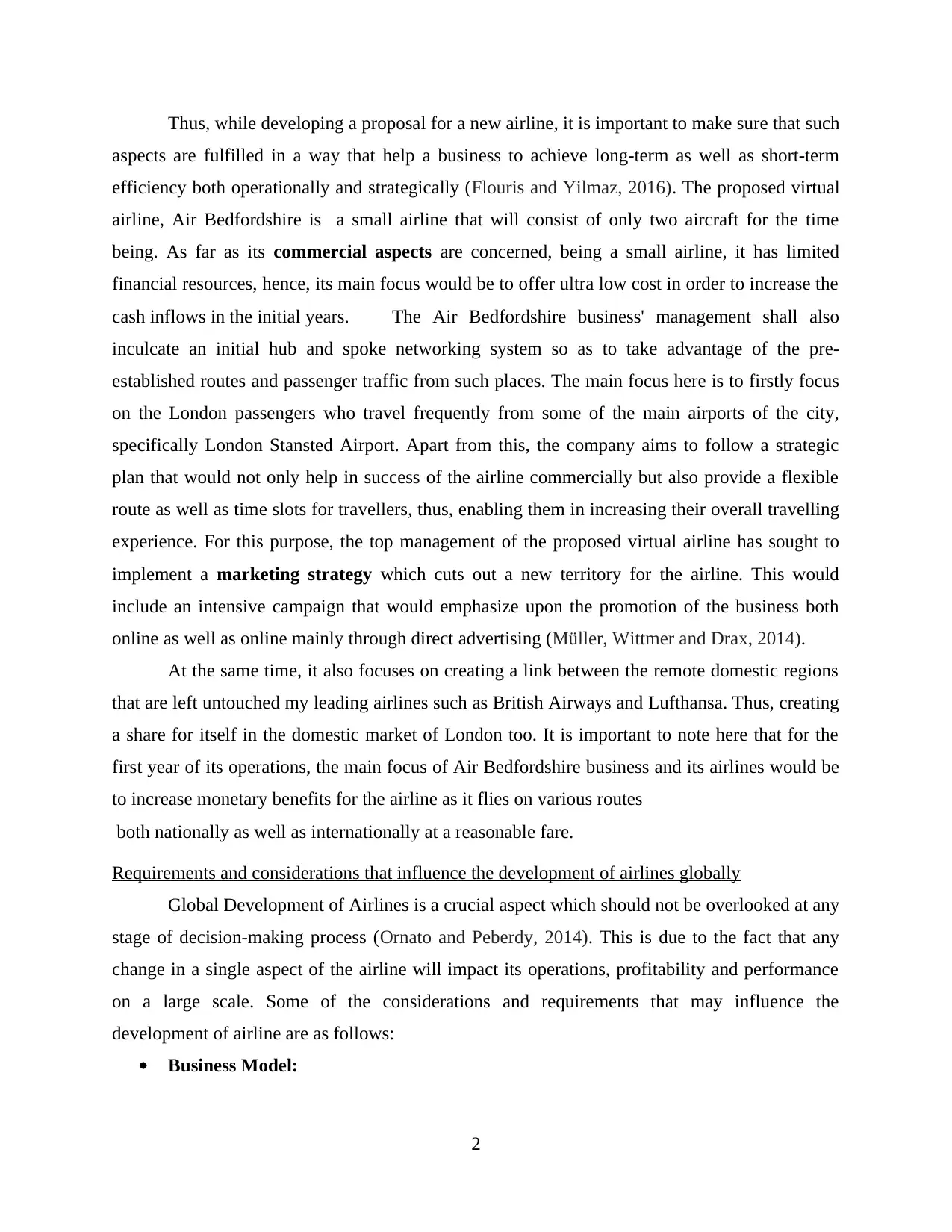
Thus, while developing a proposal for a new airline, it is important to make sure that such
aspects are fulfilled in a way that help a business to achieve long-term as well as short-term
efficiency both operationally and strategically (Flouris and Yilmaz, 2016). The proposed virtual
airline, Air Bedfordshire is a small airline that will consist of only two aircraft for the time
being. As far as its commercial aspects are concerned, being a small airline, it has limited
financial resources, hence, its main focus would be to offer ultra low cost in order to increase the
cash inflows in the initial years. The Air Bedfordshire business' management shall also
inculcate an initial hub and spoke networking system so as to take advantage of the pre-
established routes and passenger traffic from such places. The main focus here is to firstly focus
on the London passengers who travel frequently from some of the main airports of the city,
specifically London Stansted Airport. Apart from this, the company aims to follow a strategic
plan that would not only help in success of the airline commercially but also provide a flexible
route as well as time slots for travellers, thus, enabling them in increasing their overall travelling
experience. For this purpose, the top management of the proposed virtual airline has sought to
implement a marketing strategy which cuts out a new territory for the airline. This would
include an intensive campaign that would emphasize upon the promotion of the business both
online as well as online mainly through direct advertising (Müller, Wittmer and Drax, 2014).
At the same time, it also focuses on creating a link between the remote domestic regions
that are left untouched my leading airlines such as British Airways and Lufthansa. Thus, creating
a share for itself in the domestic market of London too. It is important to note here that for the
first year of its operations, the main focus of Air Bedfordshire business and its airlines would be
to increase monetary benefits for the airline as it flies on various routes
both nationally as well as internationally at a reasonable fare.
Requirements and considerations that influence the development of airlines globally
Global Development of Airlines is a crucial aspect which should not be overlooked at any
stage of decision-making process (Ornato and Peberdy, 2014). This is due to the fact that any
change in a single aspect of the airline will impact its operations, profitability and performance
on a large scale. Some of the considerations and requirements that may influence the
development of airline are as follows:
Business Model:
2
aspects are fulfilled in a way that help a business to achieve long-term as well as short-term
efficiency both operationally and strategically (Flouris and Yilmaz, 2016). The proposed virtual
airline, Air Bedfordshire is a small airline that will consist of only two aircraft for the time
being. As far as its commercial aspects are concerned, being a small airline, it has limited
financial resources, hence, its main focus would be to offer ultra low cost in order to increase the
cash inflows in the initial years. The Air Bedfordshire business' management shall also
inculcate an initial hub and spoke networking system so as to take advantage of the pre-
established routes and passenger traffic from such places. The main focus here is to firstly focus
on the London passengers who travel frequently from some of the main airports of the city,
specifically London Stansted Airport. Apart from this, the company aims to follow a strategic
plan that would not only help in success of the airline commercially but also provide a flexible
route as well as time slots for travellers, thus, enabling them in increasing their overall travelling
experience. For this purpose, the top management of the proposed virtual airline has sought to
implement a marketing strategy which cuts out a new territory for the airline. This would
include an intensive campaign that would emphasize upon the promotion of the business both
online as well as online mainly through direct advertising (Müller, Wittmer and Drax, 2014).
At the same time, it also focuses on creating a link between the remote domestic regions
that are left untouched my leading airlines such as British Airways and Lufthansa. Thus, creating
a share for itself in the domestic market of London too. It is important to note here that for the
first year of its operations, the main focus of Air Bedfordshire business and its airlines would be
to increase monetary benefits for the airline as it flies on various routes
both nationally as well as internationally at a reasonable fare.
Requirements and considerations that influence the development of airlines globally
Global Development of Airlines is a crucial aspect which should not be overlooked at any
stage of decision-making process (Ornato and Peberdy, 2014). This is due to the fact that any
change in a single aspect of the airline will impact its operations, profitability and performance
on a large scale. Some of the considerations and requirements that may influence the
development of airline are as follows:
Business Model:
2
Paraphrase This Document
Need a fresh take? Get an instant paraphrase of this document with our AI Paraphraser
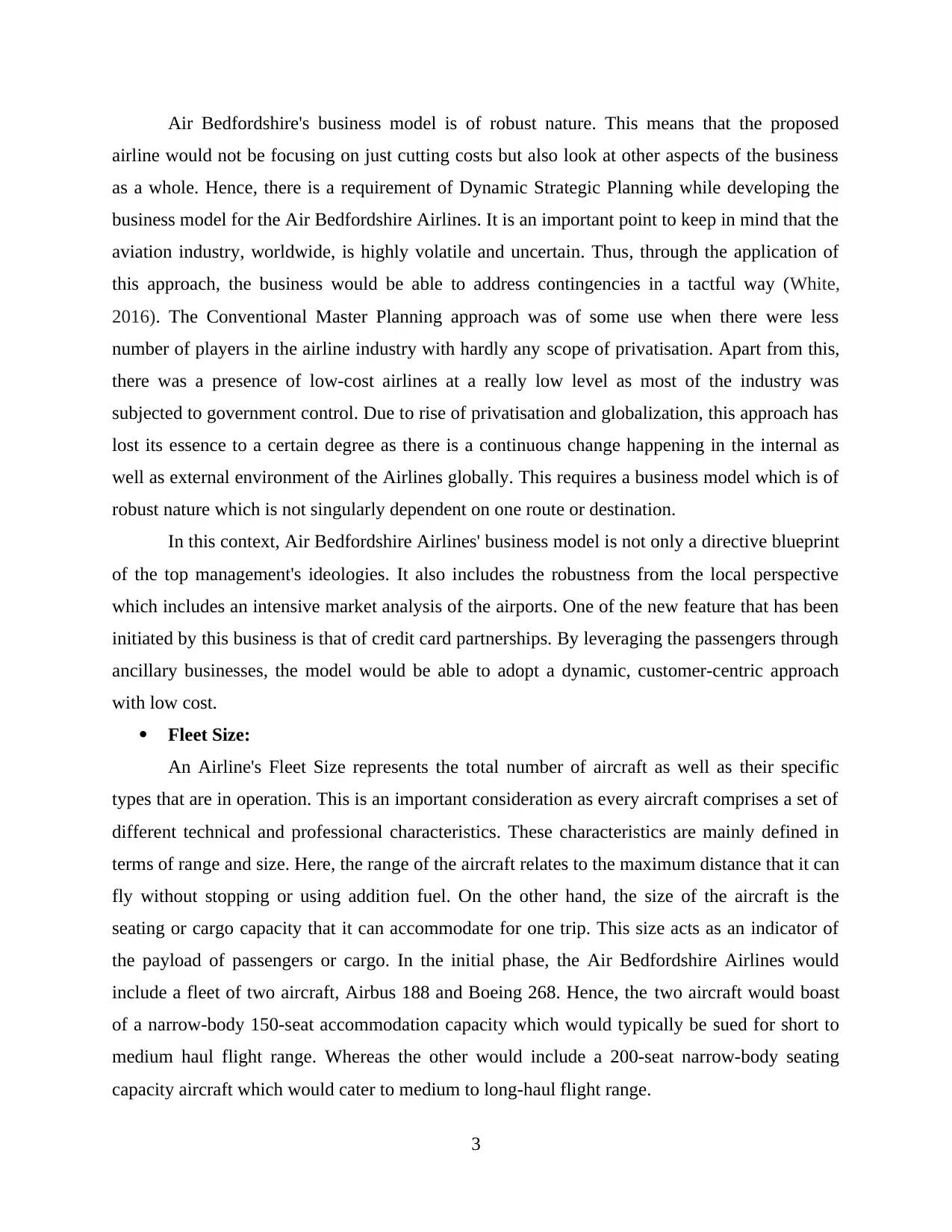
Air Bedfordshire's business model is of robust nature. This means that the proposed
airline would not be focusing on just cutting costs but also look at other aspects of the business
as a whole. Hence, there is a requirement of Dynamic Strategic Planning while developing the
business model for the Air Bedfordshire Airlines. It is an important point to keep in mind that the
aviation industry, worldwide, is highly volatile and uncertain. Thus, through the application of
this approach, the business would be able to address contingencies in a tactful way (White,
2016). The Conventional Master Planning approach was of some use when there were less
number of players in the airline industry with hardly any scope of privatisation. Apart from this,
there was a presence of low-cost airlines at a really low level as most of the industry was
subjected to government control. Due to rise of privatisation and globalization, this approach has
lost its essence to a certain degree as there is a continuous change happening in the internal as
well as external environment of the Airlines globally. This requires a business model which is of
robust nature which is not singularly dependent on one route or destination.
In this context, Air Bedfordshire Airlines' business model is not only a directive blueprint
of the top management's ideologies. It also includes the robustness from the local perspective
which includes an intensive market analysis of the airports. One of the new feature that has been
initiated by this business is that of credit card partnerships. By leveraging the passengers through
ancillary businesses, the model would be able to adopt a dynamic, customer-centric approach
with low cost.
Fleet Size:
An Airline's Fleet Size represents the total number of aircraft as well as their specific
types that are in operation. This is an important consideration as every aircraft comprises a set of
different technical and professional characteristics. These characteristics are mainly defined in
terms of range and size. Here, the range of the aircraft relates to the maximum distance that it can
fly without stopping or using addition fuel. On the other hand, the size of the aircraft is the
seating or cargo capacity that it can accommodate for one trip. This size acts as an indicator of
the payload of passengers or cargo. In the initial phase, the Air Bedfordshire Airlines would
include a fleet of two aircraft, Airbus 188 and Boeing 268. Hence, the two aircraft would boast
of a narrow-body 150-seat accommodation capacity which would typically be sued for short to
medium haul flight range. Whereas the other would include a 200-seat narrow-body seating
capacity aircraft which would cater to medium to long-haul flight range.
3
airline would not be focusing on just cutting costs but also look at other aspects of the business
as a whole. Hence, there is a requirement of Dynamic Strategic Planning while developing the
business model for the Air Bedfordshire Airlines. It is an important point to keep in mind that the
aviation industry, worldwide, is highly volatile and uncertain. Thus, through the application of
this approach, the business would be able to address contingencies in a tactful way (White,
2016). The Conventional Master Planning approach was of some use when there were less
number of players in the airline industry with hardly any scope of privatisation. Apart from this,
there was a presence of low-cost airlines at a really low level as most of the industry was
subjected to government control. Due to rise of privatisation and globalization, this approach has
lost its essence to a certain degree as there is a continuous change happening in the internal as
well as external environment of the Airlines globally. This requires a business model which is of
robust nature which is not singularly dependent on one route or destination.
In this context, Air Bedfordshire Airlines' business model is not only a directive blueprint
of the top management's ideologies. It also includes the robustness from the local perspective
which includes an intensive market analysis of the airports. One of the new feature that has been
initiated by this business is that of credit card partnerships. By leveraging the passengers through
ancillary businesses, the model would be able to adopt a dynamic, customer-centric approach
with low cost.
Fleet Size:
An Airline's Fleet Size represents the total number of aircraft as well as their specific
types that are in operation. This is an important consideration as every aircraft comprises a set of
different technical and professional characteristics. These characteristics are mainly defined in
terms of range and size. Here, the range of the aircraft relates to the maximum distance that it can
fly without stopping or using addition fuel. On the other hand, the size of the aircraft is the
seating or cargo capacity that it can accommodate for one trip. This size acts as an indicator of
the payload of passengers or cargo. In the initial phase, the Air Bedfordshire Airlines would
include a fleet of two aircraft, Airbus 188 and Boeing 268. Hence, the two aircraft would boast
of a narrow-body 150-seat accommodation capacity which would typically be sued for short to
medium haul flight range. Whereas the other would include a 200-seat narrow-body seating
capacity aircraft which would cater to medium to long-haul flight range.
3
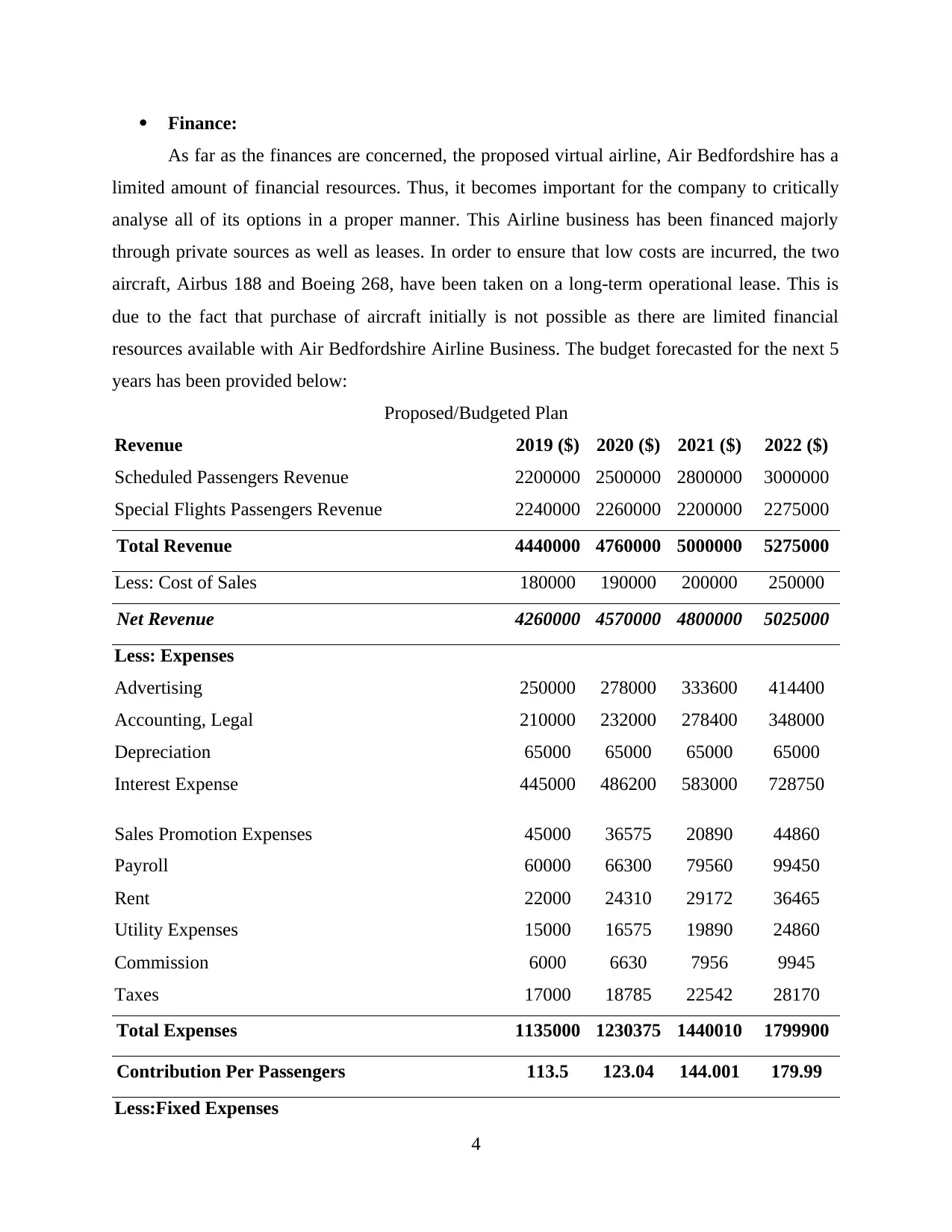
Finance:
As far as the finances are concerned, the proposed virtual airline, Air Bedfordshire has a
limited amount of financial resources. Thus, it becomes important for the company to critically
analyse all of its options in a proper manner. This Airline business has been financed majorly
through private sources as well as leases. In order to ensure that low costs are incurred, the two
aircraft, Airbus 188 and Boeing 268, have been taken on a long-term operational lease. This is
due to the fact that purchase of aircraft initially is not possible as there are limited financial
resources available with Air Bedfordshire Airline Business. The budget forecasted for the next 5
years has been provided below:
Proposed/Budgeted Plan
Revenue 2019 ($) 2020 ($) 2021 ($) 2022 ($)
Scheduled Passengers Revenue 2200000 2500000 2800000 3000000
Special Flights Passengers Revenue 2240000 2260000 2200000 2275000
Total Revenue 4440000 4760000 5000000 5275000
Less: Cost of Sales 180000 190000 200000 250000
Net Revenue 4260000 4570000 4800000 5025000
Less: Expenses
Advertising 250000 278000 333600 414400
Accounting, Legal 210000 232000 278400 348000
Depreciation 65000 65000 65000 65000
Interest Expense 445000 486200 583000 728750
Sales Promotion Expenses 45000 36575 20890 44860
Payroll 60000 66300 79560 99450
Rent 22000 24310 29172 36465
Utility Expenses 15000 16575 19890 24860
Commission 6000 6630 7956 9945
Taxes 17000 18785 22542 28170
Total Expenses 1135000 1230375 1440010 1799900
Contribution Per Passengers 113.5 123.04 144.001 179.99
Less:Fixed Expenses
4
As far as the finances are concerned, the proposed virtual airline, Air Bedfordshire has a
limited amount of financial resources. Thus, it becomes important for the company to critically
analyse all of its options in a proper manner. This Airline business has been financed majorly
through private sources as well as leases. In order to ensure that low costs are incurred, the two
aircraft, Airbus 188 and Boeing 268, have been taken on a long-term operational lease. This is
due to the fact that purchase of aircraft initially is not possible as there are limited financial
resources available with Air Bedfordshire Airline Business. The budget forecasted for the next 5
years has been provided below:
Proposed/Budgeted Plan
Revenue 2019 ($) 2020 ($) 2021 ($) 2022 ($)
Scheduled Passengers Revenue 2200000 2500000 2800000 3000000
Special Flights Passengers Revenue 2240000 2260000 2200000 2275000
Total Revenue 4440000 4760000 5000000 5275000
Less: Cost of Sales 180000 190000 200000 250000
Net Revenue 4260000 4570000 4800000 5025000
Less: Expenses
Advertising 250000 278000 333600 414400
Accounting, Legal 210000 232000 278400 348000
Depreciation 65000 65000 65000 65000
Interest Expense 445000 486200 583000 728750
Sales Promotion Expenses 45000 36575 20890 44860
Payroll 60000 66300 79560 99450
Rent 22000 24310 29172 36465
Utility Expenses 15000 16575 19890 24860
Commission 6000 6630 7956 9945
Taxes 17000 18785 22542 28170
Total Expenses 1135000 1230375 1440010 1799900
Contribution Per Passengers 113.5 123.04 144.001 179.99
Less:Fixed Expenses
4
⊘ This is a preview!⊘
Do you want full access?
Subscribe today to unlock all pages.

Trusted by 1+ million students worldwide

Fixed Marketing Expenses 25000 25000 25000 25000
Fixed Administrative Expenses 35000 35000 35000 35000
Total Fixed Expenses 60000 60000 60000 60000
Net Profit 3245000 3469625 3499990 3415100
Break Even Point (Fixed Cost/ Contribution) 528.63 487.66 416.66 333.35
Investment (Cost) 2092000 2248830 2578500 3072740
ROI [Investment(cost)/ Net Profit] 0.64% 0.65% 0.74% 0.90%
Networks and Routes:
The core idea of this airline is to have a multitude of networks and routes so as to avoid
heavy competition from established low-fare carriers such as British Airways and Lufthansa. The
main issue with new airlines is that a single route would cause the airline to have a single cash
flow source (Wilke, Majumdar and Ochieng, 2014). This would result in total dependence of the
airline on the passengers travelling through that route itself. Hence, in order to avoid such a
situation, a hub and spoke network structure has been adopted wherein the hub would be the
London Stansted Airport whereas the spokes would include both domestic as well as
international airports based in Heathrow, China and USA among others.
CONCLUSION
From the above report it can be concluded that Aviation Operations Management is a
crucial tool when it comes to a start-up of an airline business. This is due to the fact that an
airline system has a lot of crucial aspects, usually commercial and strategical, that impact the
overall performance as well as profitability of the airline as a whole. Apart from this, basic
requirements and considerations such as Business Model, Finances, Networks, Routes and Fleet
Size also determine what type of strategies an airline business must adopt in order to avoid
uncertainty, volatility and plan for future contingencies.
5
Fixed Administrative Expenses 35000 35000 35000 35000
Total Fixed Expenses 60000 60000 60000 60000
Net Profit 3245000 3469625 3499990 3415100
Break Even Point (Fixed Cost/ Contribution) 528.63 487.66 416.66 333.35
Investment (Cost) 2092000 2248830 2578500 3072740
ROI [Investment(cost)/ Net Profit] 0.64% 0.65% 0.74% 0.90%
Networks and Routes:
The core idea of this airline is to have a multitude of networks and routes so as to avoid
heavy competition from established low-fare carriers such as British Airways and Lufthansa. The
main issue with new airlines is that a single route would cause the airline to have a single cash
flow source (Wilke, Majumdar and Ochieng, 2014). This would result in total dependence of the
airline on the passengers travelling through that route itself. Hence, in order to avoid such a
situation, a hub and spoke network structure has been adopted wherein the hub would be the
London Stansted Airport whereas the spokes would include both domestic as well as
international airports based in Heathrow, China and USA among others.
CONCLUSION
From the above report it can be concluded that Aviation Operations Management is a
crucial tool when it comes to a start-up of an airline business. This is due to the fact that an
airline system has a lot of crucial aspects, usually commercial and strategical, that impact the
overall performance as well as profitability of the airline as a whole. Apart from this, basic
requirements and considerations such as Business Model, Finances, Networks, Routes and Fleet
Size also determine what type of strategies an airline business must adopt in order to avoid
uncertainty, volatility and plan for future contingencies.
5
Paraphrase This Document
Need a fresh take? Get an instant paraphrase of this document with our AI Paraphraser
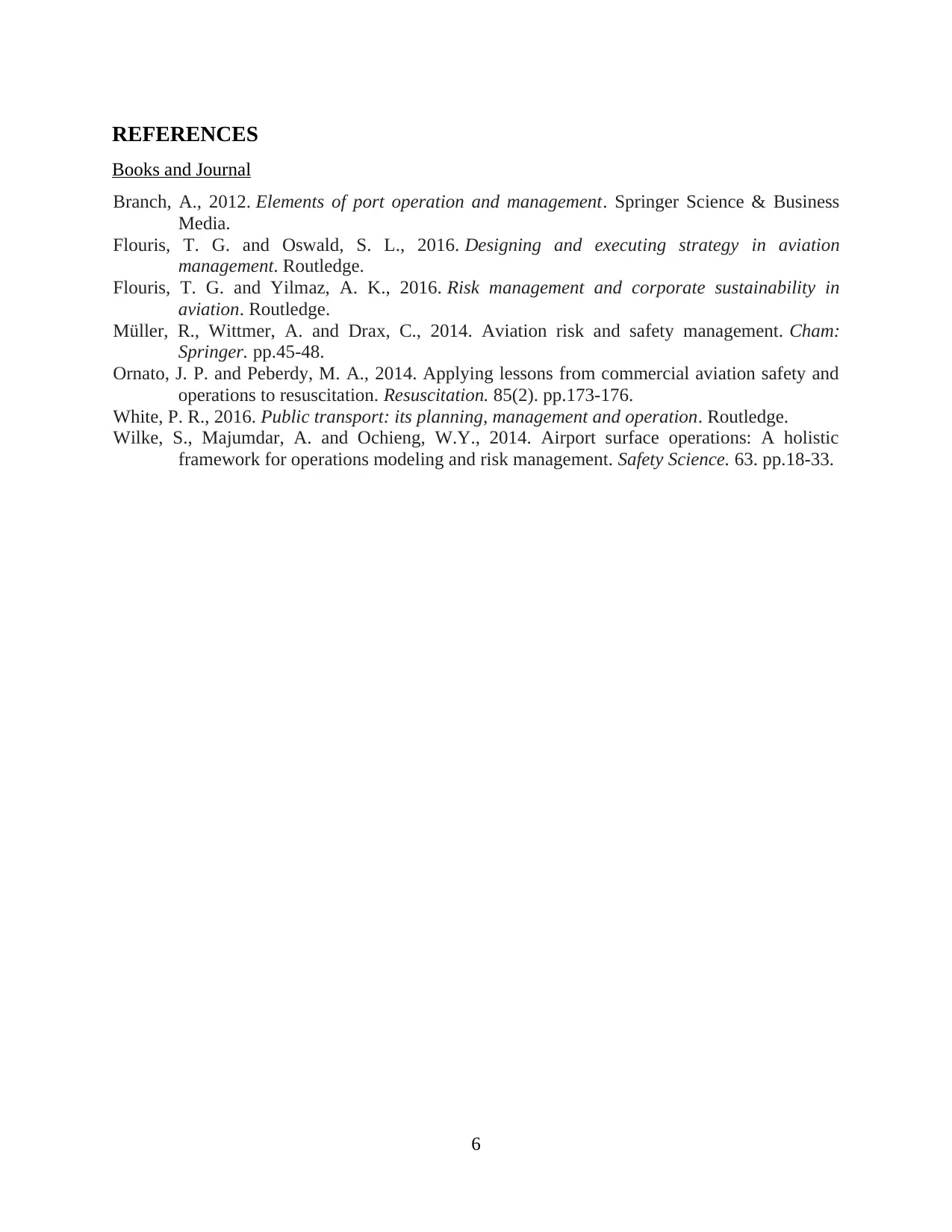
REFERENCES
Books and Journal
Branch, A., 2012. Elements of port operation and management. Springer Science & Business
Media.
Flouris, T. G. and Oswald, S. L., 2016. Designing and executing strategy in aviation
management. Routledge.
Flouris, T. G. and Yilmaz, A. K., 2016. Risk management and corporate sustainability in
aviation. Routledge.
Müller, R., Wittmer, A. and Drax, C., 2014. Aviation risk and safety management. Cham:
Springer. pp.45-48.
Ornato, J. P. and Peberdy, M. A., 2014. Applying lessons from commercial aviation safety and
operations to resuscitation. Resuscitation. 85(2). pp.173-176.
White, P. R., 2016. Public transport: its planning, management and operation. Routledge.
Wilke, S., Majumdar, A. and Ochieng, W.Y., 2014. Airport surface operations: A holistic
framework for operations modeling and risk management. Safety Science. 63. pp.18-33.
6
Books and Journal
Branch, A., 2012. Elements of port operation and management. Springer Science & Business
Media.
Flouris, T. G. and Oswald, S. L., 2016. Designing and executing strategy in aviation
management. Routledge.
Flouris, T. G. and Yilmaz, A. K., 2016. Risk management and corporate sustainability in
aviation. Routledge.
Müller, R., Wittmer, A. and Drax, C., 2014. Aviation risk and safety management. Cham:
Springer. pp.45-48.
Ornato, J. P. and Peberdy, M. A., 2014. Applying lessons from commercial aviation safety and
operations to resuscitation. Resuscitation. 85(2). pp.173-176.
White, P. R., 2016. Public transport: its planning, management and operation. Routledge.
Wilke, S., Majumdar, A. and Ochieng, W.Y., 2014. Airport surface operations: A holistic
framework for operations modeling and risk management. Safety Science. 63. pp.18-33.
6
1 out of 8
Related Documents
Your All-in-One AI-Powered Toolkit for Academic Success.
+13062052269
info@desklib.com
Available 24*7 on WhatsApp / Email
![[object Object]](/_next/static/media/star-bottom.7253800d.svg)
Unlock your academic potential
Copyright © 2020–2025 A2Z Services. All Rights Reserved. Developed and managed by ZUCOL.





